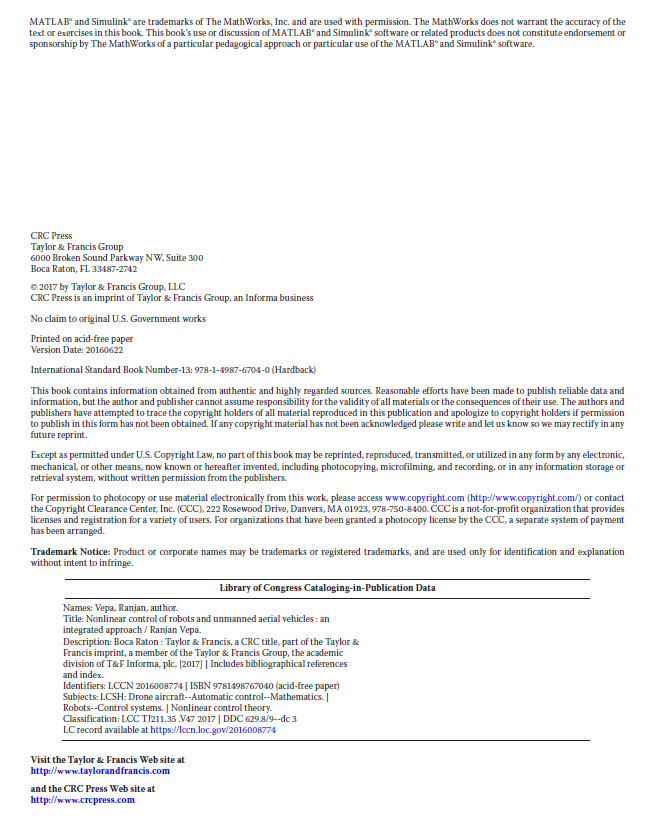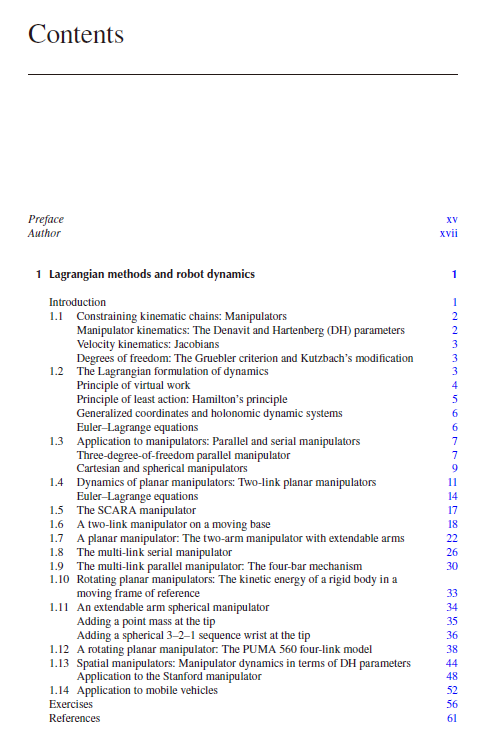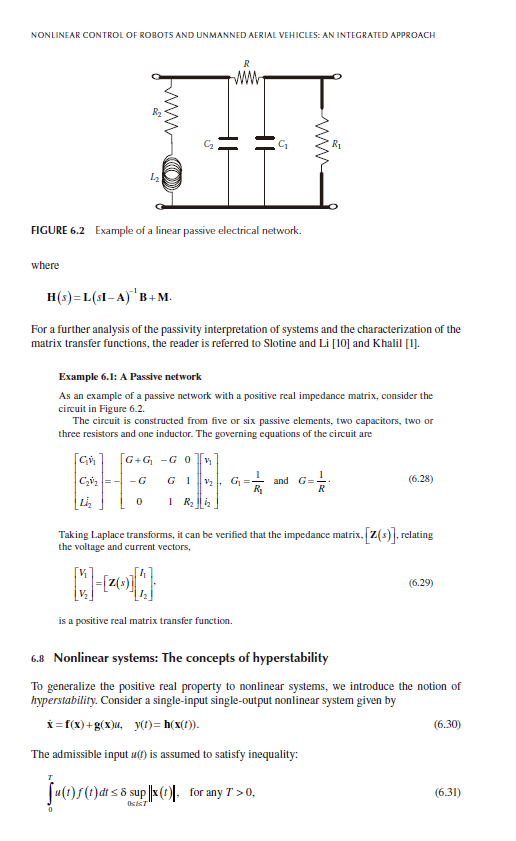马上注册,结交更多好友,享用更多功能,让你轻松玩转社区。
您需要 登录 才可以下载或查看,没有账号?立即注册

×
《Nonlinear Control of Robots and Unmanned Aerial Vehicles: An Integrated Approach》
机器人与无人飞行器的非线性控制:综合方法
作者:Ranjan Vepa
出版社:CRC
出版时间:2017年
《Nonlinear Control of Robots and Unmanned Aerial Vehicles: An Integrated Approach》

《Nonlinear Control of Robots and Unmanned Aerial Vehicles: An Integrated Approach》

《Nonlinear Control of Robots and Unmanned Aerial Vehicles: An Integrated Approach》

《Nonlinear Control of Robots and Unmanned Aerial Vehicles: An Integrated Approach》

目录
Preface xv
Author xvii
1 Lagrangian methods and robot dynamics 1
Introduction 1
1.1 Constraining kinematic chains: Manipulators 2
Manipulator kinematics: The Denavit and Hartenberg (DH) parameters 2
Velocity kinematics: Jacobians 3
Degrees of freedom: The Gruebler criterion and Kutzbach’s modification 3
1.2 The Lagrangian formulation of dynamics 3
Principle of virtual work 4
Principle of least action: Hamilton’s principle 5
Generalized coordinates and holonomic dynamic systems 6
Euler–Lagrange equations
6
1.3 Application to manipulators: Parallel and serial manipulators 7
Three-degree-of-freedom
parallel manipulator 7
Cartesian and spherical manipulators 9
1.4 Dynamics of planar manipulators: Two-link planar manipulators 11
Euler–Lagrange equations
14
1.5 The SCARA manipulator 17
1.6 A two-link manipulator on a moving base 18
1.7 A planar manipulator: The two-arm manipulator with extendable arms 22
1.8 The multi-link serial manipulator 26
1.9 The multi-link parallel manipulator: The four-bar mechanism 30
1.10 Rotating planar manipulators: The kinetic energy of a rigid body in a
moving frame of reference 33
1.11 An extendable arm spherical manipulator 34
Adding
a point mass at the tip 35
Adding a spherical 3–2–1 sequence wrist at the tip 36
1.12 A rotating planar manipulator: The PUMA 560 four-link model 38
1.13 Spatial manipulators: Manipulator dynamics in terms of DH parameters 44
Application to the Stanford manipulator 48
1.14 Application to mobile vehicles 52
Exercises 56
References 61
2 Unmanned aerial vehicle dynamics and Lagrangian methods 63
2.1 Flight dynamics of UAVs 63
2.2 Newton–Euler equations of a rigid aircraft 64
Lagrangian and Hamiltonian formulations 69
2.3 Euler–Lagrange equations of motion in quasi-coordinates 69
Transformation to centre of mass coordinates 73
Application of the Lagrangian method to a rigid aircraft 75
2.4 Complete equations of motion of UAV 79
Equations of motion in wind axis coordinates, VT, α and β 83
Forces and moments due to engine thrust 88
Equations of motion in velocity axes 88
2.5 Direct inversion of attitude dynamics 93
Exercises 96
References 98
3 Feedback linearization 99
Introduction 99
3.1 Lie derivatives, Lie brackets and Lie algebra 99
3.2 Feedback linearization: Pure feedback systems 100
3.3 Input–output feedback linearization 102
3.4 Partial state feedback linearization 104
3.5 Input to state feedback linearization 105
3.6 Applications of feedback linearization 105
3.7 Feedback decoupling 115
3.8 Dynamic feedback linearization 123
3.9 Partial feedback linearization of the ACROBOT 126
Evolution of the humanoid robot model 126
Dynamic models of the ACROBOT 126
Partial feedback linearization 127
Defining the transformations of the state vector 129
The relative degree with T1 ≡ 0, the output and zero dynamics 133
An alternate approach to feedback linearization 133
Exercises 134
References 136
4 Linear and phase plane analysis of stability 139
Introduction 139
4.1 The phase plane 139
4.2 Equilibrium and stability: Lyapunov’s first method 140
Regular and singular points 147
The saddle point 149
Sinks or attractors: Focus, spiral, node and improper node 151
Centre 151
Sources or repellers 151
Limit cycles 152
Stability analysis of nonlinear vibrating systems with linear damping 154
4.3 Response of nonlinear vibrating systems: Geometric and algebraic
approaches 161
Non-numerical geometric methods 161
Numerically oriented geometric methods 163
The perturbation method 165
Variation of parameters 171
Harmonic balance and describing functions 174
4.4 Examples of nonlinear systems and their analysis 175
Undamped free vibration of a simple
pendulum 175
Duffing oscillator: Approximate analysis of the forced vibration of a
nonlinear oscillator 184
Van der Pol oscillator: The occurrence of periodic oscillations in a nonlinear
oscillator with nonlinear dissipation 193
4.5 Features of nonlinear system responses 195
Superharmonic response 195
Jump phenomenon 195
Subharmonic resonance 196
Combination resonance 196
Self-excited oscillations 196
Exercises 198
References 202
5 Robot and UAV control: An overview 203
Introduction 203
5.1 Controlling robot manipulators 205
5.2 Model-based and biomimetic methods of control 206
5.3 Artificial neural networks 207
5.4 Boolean logic and its quantification 210
5.5 Fuzzy sets 211
Operations on fuzzy sets 212
Relations between fuzzy sets 214
5.6 Fuzzy logic and the implications of a rule 215
5.7 Fuzzy reasoning 216
5.8 Fuzzy logic control 218
5.9 Typical application 220
Exercises 224
References 226
6 Stability 227
6.1 Stability concepts 227
6.2 Input/output stability 228
6.3 Internal stability 228
6.4 Input to state stability 228
6.5 Advanced stability concepts 228
6.6 Passive systems 229
6.7 Linear systems: The concept of passivity and positive real systems 230
6.8 Nonlinear systems: The concepts of hyperstability 232
6.9 Lure’s problem 233
6.10 Kalman–Yakubovich (KY) and other related lemmas 234
6.11 Small-gain theorem 235
6.12 Total stability theorem 236
Exercises 237
References 238
7 Lyapunov stability 241
Introduction 241
7.1 Lyapunov, asymptotic, exponential, uniform, local and global stability 242
7.2 Lyapunov’s stability theorem 243
7.3 Lyapunov’s second or direct method 243
The positive definite function 244
The Lyapunov function and its application to the synthesis of L1 controllers 244
The control Lyapunov function 244
Relationship to the ∞-norm 245
7.4 Lyapunov’s direct method: Examples 245
7.5 LaSalle’s invariant set theorems 246
7.6 Linear time-invariant (LTI) systems 247
7.7 Barbalat’s lemma and uniform ultimate boundedness 248
Exercises 249
References 251
8 Computed torque control 253
Introduction 253
8.1 Geometric path generation 254
8.2 Motion control of a robot manipulator 257
8.3 Computer simulation of robotic manipulators in MATLAB/Simulink 258
8.4 The computed torque control concept 261
8.5 Proportional–derivative (PD) and proportional–integral–derivative (PID)
auxiliary control laws 264
8.6 Choosing the demanded joint angles 265
8.7 Simulation of robot dynamics and the feedback controller 267
Exercises 267
References 267
9 Sliding mode control 269
Introduction 269
9.1 Design example 270
9.2 Phase plane trajectory shaping 273
9.3 Sliding line and sliding mode 277
9.4 The Lyapunov approach: Choosing the control law 278
9.5 Closed-loop system: The general case 279
9.6 Principles of variable structure control 281
9.7 Design of sliding mode control laws 281
9.8 Application example 282
9.9 Higher-order sliding mode control 285
9.10 Application examples 286
Second-order twisting algorithm: Inverted pendulum on a cart model 286
First-order sliding mode control 291
Second-order sliding mode control 293
Super-twisting
algorithm 294
Exercises 301
References 303
10 Parameter identification 305
Introduction 305
10.1 The parameter identification concept: Transfer function identification 306
10.2 Model parameter identification 307
10.3 Regression and least squares solution 308
10.4 Recursive parameter updating 309
10.5 Matrix inversion lemma 310
10.6 The recursive algorithm 310
10.7 Application examples: Example 10.1 311
10.8 Least squares estimation 314
10.9 The generalized least squares problem 314
10.10 The solution to the generalized least squares problem in recursive form 316
10.11 The nonlinear least squares problem 316
10.12 Application examples: Example 10.2 318
Exercises 319
References 319
11 Adaptive and model predictive control 321
11.1 The adaptive control concept 321
11.2 Basics of adaptive control 322
11.3 Self-tuning control 324
11.4 Methods of parameter identification 328
11.5 Model reference adaptive control 328
11.6 Indirect and direct adaptive control 332
11.7 Inverted pendulum on a cart model 333
Adaptive sliding mode control: The nominal and actual models of the plant 336
The regressor matrix 337
Defining the Lyapunov function and its derivative 338
Derivation of the control and adaptation laws 339
11.8 Adaptive control of a two-link serial manipulator 341
Modeling the parameter updates 343
Governing dynamics 344
Defining the Lyapunov function and its derivative 345
Derivation of the control and adaptation laws 345
11.9 PID tracking control and the sliding surface: The general approach 347
11.10 Robust adaptive control of a linear plant 349
11.11 Robust adaptive control of a robot manipulator 354
11.12 Neural network–based adaptive control 357
11.13 Model predictive control (MPC) 359
MPC with a linear prediction model 362
MPC with a nonlinear prediction model 365
Dynamic model 365
Perturbation dynamics 366
MPC with a nonlinear filter/controller 371
MPC with a nonlinear H∞ controller 375
Exercises 381
References 383
12 Lyapunov design: The backstepping approach 385
Introduction 385
12.1 Lyapunov stability 385
Definition of Lyapunov stability revisited 385
Positive definite function revisited 385
Second method of Lyapunov revisited 385
12.2 Motivating examples 386
12.3 The backstepping principle 388
12.4 The backstepping lemma 390
12.5 Relationship to H∞ control 392
12.6 Model matching, decoupling and inversion 394
12.7 Application of the backstepping lemma 396
12.8 Design of a backstepping control law for the ACROBOT 406
Construction of a Lyapunov function 406
Construction of a Lyapunov function 407
12.9 Designing the auxiliary controller for the alternate feedback linearization 413
Construction of a Lyapunov function 414
Reducing the control law 418
Exercises 421
References 422
13 Hybrid position and force control 425
Introduction 425
13.1 Hybrid position and force control (direct force control) 430
Example: Hybrid force–position control by decoupling the position and
force control loops 430
Motion constraint equations for the end-effector tip to the maintain contact 431
Modeling the system for decoupling control 432
Defining the auxiliary
controls 434
The decoupling control law 436
13.2 Hybrid position and force control: The general theory 438
13.3 Indirect adaptive control of position and force 442
13.4 Direct adaptive control of impedance 443
13.5 Sliding mode control of impedance and position 445
13.6 Operational space concept 447
13.7 Active interaction control 449
13.8 Coordinated spatial control of multiple serial manipulators in contact with
an object 450
13.9 Coordinated spatial control of multiple serial manipulators in contact with
a constrained object 453
Exercise 454
References 454
14 UAV control 457
Introduction 457
14.1 Aircraft/UAV parameter estimation 458
14.2 Application of parameter estimation to stability and control 459
14.3 Motion control of rigid bodies 471
14.4 Nonlinear dynamic inversion 476
Scalar and vector backstepping 477
Examples 478
14.5 Dynamics of a quadrotor UAV 487
14.6 Backstepping control of the quadrotor 490
14.7 Backstepping control of a fixed-wing aircraft 497
14.8 Adaptive control of UAVs 504
14.9 Flight control of UAVs with dynamic inversion control 506
Stability of the closed loop without adaptation 508
Adaptive dynamic inversion 510
Stability of the closed loop with adaptation 511
14.10 Adaptive flight path tracking of fixed-wing UAVs 513
14.11 Adaptive attitude control of fixed-wing UAVs 517
14.12 Attitude control of fixed-wing UAVs with adaptive dynamic inversion 521
14.13 Guidance of UAVs 522
Basic flight planning 523
Line-of-sight (LOS)-based pursuit guidance 529
Straight-line guidance 530
Exercises 530
References 533
Index 537
专业书籍
下载地址:(回复后可见)
| ![]()